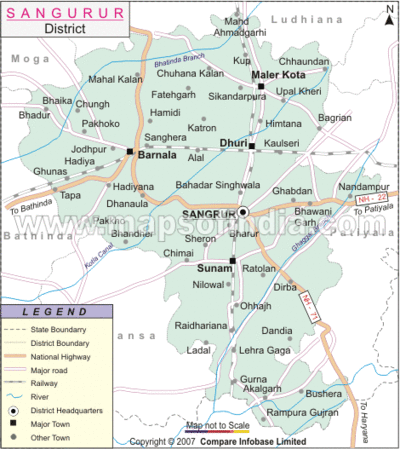Bugar
Bugar is village in Sangrur tahsil of Sangrur district in Punjab.
Contents
Jat gotras
History
Lepel H. Griffin[1] writes that originator of Rulers of Patiala, Phul had seven children from whom have descended many noble families. By his first wife, Bali, the daughter of a zamindar of Dilami in Nabha, he had three sons, Tilokha, Rama, and Rughu, and one daughter, Rami Ram Kour or Fatoh, whom he married to a Sirdar of Ram Das, giving her as a dowry the village of Bugar, which her descendants still possess.
The case of village of Bugar
Lepel H. Griffin writes: [2] writes thatThere were several other Pattiala cases, besides that of the Chaharumi Sikhs, difficult to Settle, a brief account of
which is necessary here. The first of these relates to the village of Bugar, and the case is chiefly interesting from a ruling of the Supreme Government with reference to the investigation of rights which had accrued previous to 1809.
Granted to Bibe Fatoh by her brothers Rama and Tilokha:
This village, which must not be confounded with one granted to Pattiala in 1855, had been originally given by Rama and Tilokha, the sons of Phul, to their sister Fatoh, whose descendants still own it. Both Pattiala and Nabha, the descendants of the original grantees, claimed jurisdiction over Bugar; and the jagirdars were divided into two parties, favoring the claim of the respective States, while the cultivators of the village asserted that both Nabha and Pattiala exercised jurisdiction and inflicted fines. The Commissioner Cis-Satlej States held that neither had a right to the village, which had been granted when the ancestors of the Pattiala and Nabha Chiefs were mere zamindars, subjects of the Dehli Emperor who received the Imperial share of the revenue of Bugar as of other villages, and that the British Government, in taking the place of that of Dehli, had succeeded to its jurisdiction also. It was, besides, unjust to the people to make them over to either State, for partisans of the one would be, in any case, oppressed by the triumphant partisans of the other ; while to continue the joint jurisdiction of both in a single village was impossible.
The Government of India declined to take this which declined to view of the case. The argument drawn from the status at the time of the grant was asserted to be fallacious, for the proclamations of Sir D. Ochterlony, in 1809 and
1811, had absolutely shut the door against the investigations of anterior rights, and guaranteed the Chiefs of the Cis-Satlej in the exercise of the same rights and authority, within their possessions, which they enjoyed before they were taken under British protection. As the village, at the date of the proclamation, was under the jurisdiction of either Pattiala or Nabha, it would be a breach of the agreement then made to extend the British authority over the village. The inconvenience to the people by giving Bugar to either State might be great, but this, though matter of regret, did not, in any way, affect the merits of the question, or render a breach of the distinct understanding on which the Government assumed the protection of the Cis-Satlej States any less objectionable. It was manifest that the Government could not interfere in favor of the rights of all the people of India, to whomsoever they might happen to be subject ; and it was ordered that the village should be given to Pattiala or Nabha, as appeared the most appropriate.
The village assigned to Nabha:
After some further discussion, the village was assigned to the Raja of Nabha, the Maharaja of Pattiala acquiescing in the decision.
Population
Notable persons
External links
References
Back to Jat villages
